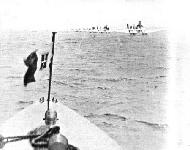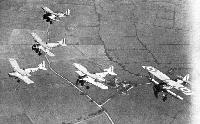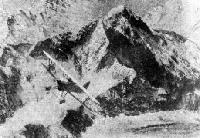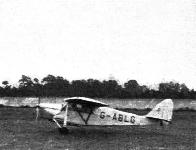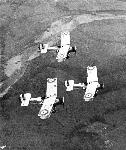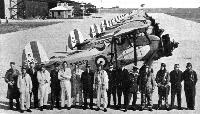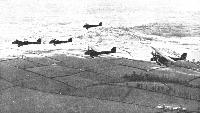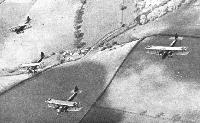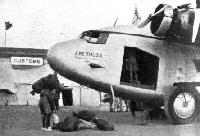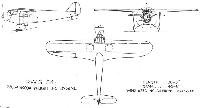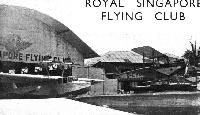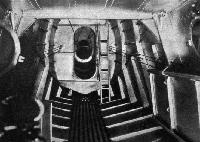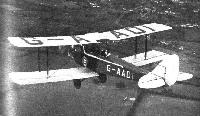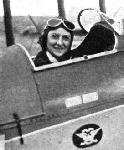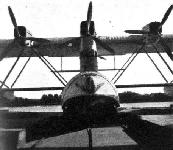Фотографии
-
THE CURTISS F.11C-2 recently supplied to the U.S. Navy.
Самолёты на фотографии: Curtiss F11C / Hawk II / BFC-2 / Model 35 - США - 1932
-
HOME AGAIN: Some of the Italian flying boats circling over Rome before alighting.
Самолёты на фотографии: Savoia-Marchetti / SIAI S.55 - Италия - 1924
-
The Armada arrives at New York, July 19; note the U.S. airship Macon in the background.
Самолёты на фотографии: Savoia-Marchetti / SIAI S.55 - Италия - 1924
-
Balbo's "Aerial Armada" at their buoys in the St. Lawrence River, Montreal, on their arrival, July 14.
Самолёты на фотографии: Savoia-Marchetti / SIAI S.55 - Италия - 1924
-
THE PROTOTYPE: This picture of Mr. Miles flying the first "Hawk" was taken some time ago, and certain changes have been made in the Production Model, notably the fitting of an undercarriage incorporating Dowty shock-absorber legs.
Самолёты на фотографии: Miles Hawk / M.2 - Великобритания - 1932
-
TRAINING TYPES: The machines from top to bottom are "Atlas," "Tutor," "Tiger Moth," "Tomtit" and "Siskin."
Самолёты на фотографии: Armstrong Whitworth Atlas / Ajax - Великобритания - 1925Armstrong Whitworth Siskin - Великобритания - 1921Avro Tutor/Sea Tutor/Prefect / Type 621/646/626 - Великобритания - 1929De Havilland Tiger Moth / D.H.82 - Великобритания - 1931Hawker Tomtit - Великобритания - 1928
-
Регистрационный номер: G-ACHI Westland "Wessex" (3 7 cyl. "Genet") eight seater.
Самолёты на фотографии: Westland Wessex / Westland IV - Великобритания - 1929
-
Регистрационный номер: C4964, G-EAER, VH-UQI The "Veteran" Bristol monoplane in flight.
With a Gipsy engine, being flown by Horrie Miller late in 1931Самолёты на фотографии: Bristol M.1A / M.1B / M.1C - Великобритания - 1916
-
EVEREST CONQUERED AGAIN: A "Skybird" Model of a Hawker Super "Fury" over the Himalayas.
Самолёты на фотографии: Hawker Fury - Великобритания - 1931
-
FOKKERS FOR DENMARK: The Fokker C.V-E (Bristol "Pegasus") being supplied to the Danish Army Air Service.
Самолёты на фотографии: Fokker C.V / C.VI - Нидерланды - 1924
-
The Saro "Cloud" arrives at Riga for the demonstration.
Самолёты на фотографии: Saunders-Roe Cloud / A.19 - Великобритания - 1930
-
AT BRUSSELS: From left to right - John Lord; Capt. S. D. Scott (pilot); A. Wallace Barr; V. Bloos (representing Cellon in Belgium); Van der Goes (agent for Hawkers and Handley Page in Belgium); and J. de C. Ballardie.
Самолёты на фотографии: Saunders-Roe Cloud / A.19 - Великобритания - 1930
-
Регистрационный номер: G-ACGO The Saro "Cloud" in a small river at Wyszkow, in Poland, where a landing was made almost in the dark.
Самолёты на фотографии: Saunders-Roe Cloud / A.19 - Великобритания - 1930
-
Регистрационный номер: K2508 INSTRUMENT FLYING: The pupil is under the hood in the rear cockpit.
Самолёты на фотографии: Avro Tutor/Sea Tutor/Prefect / Type 621/646/626 - Великобритания - 1929
-
The Dewoitine D.332 three-engined transport monoplane ( Hispano-Suiza 9V engines). It is intended for service on the Far Eastern air routes.
Самолёты на фотографии: Dewoitine D.332 / D.333 / D.338 / D.620 - Франция - 1933
-
The cabin of the Dewoitine D.332, showing the large reclining chairs for passengers on long night flights.
Самолёты на фотографии: Dewoitine D.332 / D.333 / D.338 / D.620 - Франция - 1933
-
Регистрационный номер: F-ALAA, F-ALSK Outside the clubhouse, Buc.
F-ALAA - Potez 36.14; F-ALSK - Caudron C.278 LucioleСамолёты на фотографии: Caudron C.230 / C.270 / Luciole - Франция - 1930Potez Potez 36 - Франция - 1929
-
Самолёты на фотографии: Klemm L.25 - L.28 Swallow - Германия - 1927
-
SOME COMPETITORS: A Klemm Kl.32, piloted by Ministerialrat Christiansen, formerly skipper of the Do.X.
Самолёты на фотографии: Klemm Kl.32 / Kl.36 - Германия - 1932
-
Регистрационный номер: G-ACHX Chosen as the most suitable machine, a D.H. "Dragon" of the type to be used on air survey in Australia. Its clear outlook forward makes it ideal for the purpose. This particular machine is run on private charter work by Wrighton & Pearse at Heston, and was recently hired by the Prince of Wales.
Самолёты на фотографии: De Havilland Dragon / D.H.84 - Великобритания - 1932
-
VIA THEIR NATURAL MEDIUM: The Marconi agents from all over the country came to London for the Radio Exhibition at Olympia by means of D.H. "Dragons" (two "Gipsy Majors") chartered from Hillmans Airways. Here are some of them arriving at Heston Airport.
Самолёты на фотографии: De Havilland Dragon / D.H.84 - Великобритания - 1932
-
Самолёты на фотографии: De Havilland Dragon / D.H.84 - Великобритания - 1932
-
Регистрационный номер: G-AAUD THE KARACHI-CALCUTTA AIR MAIL: The accompanying illustrations show incidents in connection with the first air mail service between Karachi and Calcutta, which was inaugurated on July 7. Mails (635 lb.) were transferred to the Imperial Airways machine Hanno for the remaining portion of the journey to Croydon.
Самолёты на фотографии: Handley Page H.P.42 / H.P.45 - Великобритания - 1930
-
Регистрационный номер: G-ABLG Sqd. Ldr. W. L. Runciman, who came in second, is starting away.
Самолёты на фотографии: De Havilland Puss Moth / D.H.80 - Великобритания - 1929
-
Регистрационный номер: X12265 "THE HUMAN BULLET": Frank Hawks, of "Texaco," and his all-metal Northrop "Gamma" Sky-Chief, on which he made his 200 m.p.h. flight across Canada.
Самолёты на фотографии: Northrop Gamma / A-13 / A-16 - США - 1932
-
THE CURTISS A-12 recently supplied to the U.S. Army Air Corps.
Самолёты на фотографии: Curtiss A-8 / A-12 Shrike - США - 1931
-
Регистрационный номер: D-2500 "GENERALFELDMARSCHALL VON HINDENBURG": The Junkers G 38 D2500 which, as previously reported in FLIGHT, was christened at Tempelhof Aerodrome, Berlin, by the Field Marshal.
Самолёты на фотографии: Junkers G 38 - Германия - 1929
-
Регистрационный номер: G-ABSI Airspeed "Ferry" (2 "Gipsy III" and 1 "Gipsy II") ten seater.
Самолёты на фотографии: Airspeed Ferry / AS.4 - Великобритания - 1932
-
THE LINDBERGHS IN EUROPE: Col. and Mrs. Lindbergh, who have been carrying out a survey flight over the Arctic Atlantic air route, about to depart from Lerwick, Shetland Isles, for Copenhagen.
Самолёты на фотографии: Lockheed Sirius / Altair 8 - США - 1929
-
ON MEDIUM PATROL: A flight of No. 26 (Army - Co-operation) Squadron over the Yorkshire Moors.
Самолёты на фотографии: Armstrong Whitworth Atlas / Ajax - Великобритания - 1925
-
ECHELON ON THE RIGHT: Three A.W. "Atlas" machines with Armstrong-Siddeley "Jaguar" engines.
Самолёты на фотографии: Armstrong Whitworth Atlas / Ajax - Великобритания - 1925
-
TESTING WIRELESS SETS: Three different sets can be carried on the "Atlas" according to whether its duty is artillery observation, close reconnaissance, or medium reconnaissance.
Самолёты на фотографии: Armstrong Whitworth Atlas / Ajax - Великобритания - 1925
-
Регистрационный номер: K1528, K2520 FLYING INSTRUCTORS
Самолёты на фотографии: Armstrong Whitworth Atlas / Ajax - Великобритания - 1925
-
Регистрационный номер: J9997 HELPING THE INFANTRY: View of an A.W. "Atlas" picking up messages which the infantry attach to a cord stretched between two posts.
Самолёты на фотографии: Armstrong Whitworth Atlas / Ajax - Великобритания - 1925
-
ROAD PATROL: No. 26 (A.C.) Squadron patrolling along the old Roman road.
Самолёты на фотографии: Armstrong Whitworth Atlas / Ajax - Великобритания - 1925
-
Avro "Avian" ("Hermes II") two seater.
Самолёты на фотографии: Avro Avian / Type 594/616 - Великобритания - 1926
-
BRITISH AIRCRAFT IN THE FAR EAST: A batch of Avro "Avians" with "Hermes II" engines in the hangar at Kai Tak aerodrome. There are approximately 50 "Avians" in China, fitted with either the "Hermes II" or "Cirrus III" engines.
Самолёты на фотографии: Avro Avian / Type 594/616 - Великобритания - 1926
-
Avro "X" (3 "Lynx") ten seater.
Самолёты на фотографии: Avro Ten / Type 618 - Великобритания - 1928
-
"I WANT TO BE A SEAPLANE!" Mr. Ulm's Avro 10 monoplane caught by the tide at Portmarnock Strand, Dublin, when its undercarriage collapsed after being refuelled.
Самолёты на фотографии: Avro Ten / Type 618 - Великобритания - 1928
-
Регистрационный номер: G-ACHC TAKING DELIVERY: Sir Derwent Hall Caine standing by the de Havilland "Leopard Moth" ("Gipsy Major") which has just been delivered to him. This is the machine entered by Sir Derwent in the King's Cup Race, and flown by Mr. Styran.
Самолёты на фотографии: De Havilland Leopard Moth / D.H.85 - Великобритания - 1933
-
The XOJ.1 fitted with Zap Flaps and Ailerons
Самолёты на фотографии: Berliner-Joyce OJ - США - 1931
-
Регистрационный номер: G-ACAH A BLACKBURN TRAINING MACHINE: This type is equipped with camera gun, hood for blind-flying, etc., and is fitted with the "Hermes IV" inverted engine.
Самолёты на фотографии: Blackburn B-2 - Великобритания - 1931
-
THE BLACKBURN "BAFFIN": This photo, shows the prototype, as indicated by the identification letters. The engine is a Bristol "Pegasus."
Самолёты на фотографии: Blackburn Baffin / B-5 - Великобритания - 1933
-
Регистрационный номер: F-ALCC Самолёты на фотографии: Bleriot Bleriot-110 Joseph Le Brix - Франция - 1930
-
The aeroplanes lined up for the two heats of the Folkestone Aero Trophy Race. Six Comper "Swifts" took part.
Самолёты на фотографии: Comper Swift / CLA.7 - Великобритания - 1930
-
Регистрационный номер: F-ANIY, G-ACFD Georges Reginensi - and his Comper "Swift" (Pobjoy) - was a visitor to Buc when the Tourists arrived.
Pobjoy Airmotors’ director, I. C. Maxwell, took delivery of G-ACFD, but in September 1934 he sold it to French aerobatic pilot G. Reginensi and the aircraft became F-ANIY. It is seen here at Buc, in France, on July 30, 1933.Самолёты на фотографии: Comper Swift / CLA.7 - Великобритания - 1930
-
Регистрационный номер: G-ABWW F/O. H. H. Leech waiting for Mr. Reynolds to drop his flag at Brooklands. Messrs. Dancy and Rowarth, the handicappers, are standing behind the Comper "Swift" (Gipsy Major), but although Leech got the fastest time in the race he did not beat their allowance sufficiently to win.
Самолёты на фотографии: Comper Swift / CLA.7 - Великобритания - 1930
-
Mr. A. Henshaw, who came in first in both races, but was unfortunately disqualified for cutting a corner in the first. He has recently taught his father (standing behind the machine) to fly, and now the two are seen together at all meetings.
Самолёты на фотографии: Comper Swift / CLA.7 - Великобритания - 1930
-
Регистрационный номер: G-ABUU Flt. Lt. G. H. Stainforth, who came in third in the London-Newcastle Race, is here seen in the cockpit and also taking off in his Comper "Swift" (Pobjoy).
Самолёты на фотографии: Comper Swift / CLA.7 - Великобритания - 1930
-
Самолёты на фотографии: Handley Page Hyderabad/H.P.24 / Hinaidi/H.P.33 / Clive/H.P.35 - Великобритания - 1923
-
ON A LONG RAID: Night bombers work singly at night, but on a long raid by day these Handley Page "Hinaidis" fly in formation.
Самолёты на фотографии: Handley Page Hyderabad/H.P.24 / Hinaidi/H.P.33 / Clive/H.P.35 - Великобритания - 1923
-
THE UNDERSTUDIES: The earthly trail of No. 99 (Bomber) Squadron.
Самолёты на фотографии: Handley Page Hyderabad/H.P.24 / Hinaidi/H.P.33 / Clive/H.P.35 - Великобритания - 1923
-
C. W. A. Scott, the leader of the Pageant, standing beside his "Fox Moth" (Gipsy III).
Самолёты на фотографии: De Havilland Fox Moth / D.H.83 - Великобритания - 1932
-
Регистрационный номер: G-ABUO D.H. "Fox Moth" ("Gipsy III").
Самолёты на фотографии: De Havilland Fox Moth / D.H.83 - Великобритания - 1932
-
Регистрационный номер: G-ABPI [2], VT-AEF [2] THE NATURALISED INDIAN: The Armstrong-Whitworth airliner Arethusa, now operated over the Indian section by Indian Transcontinental Airways.
Самолёты на фотографии: Armstrong Whitworth Atalanta / A.W.15 - Великобритания - 1932
-
Регистрационный номер: G-ABPI [2], VT-AEF [2] THE KARACHI-CALCUTTA AIR MAIL: The accompanying illustrations show incidents in connection with the first air mail service between Karachi and Calcutta, which was inaugurated on July 7. Our picture shows the Armstrong-Whitworth Arethusa, of Indian Trans-Continental Airways, unloading mails from Calcutta at Karachi on the homeward journey on July 12.
Самолёты на фотографии: Armstrong Whitworth Atalanta / A.W.15 - Великобритания - 1932
-
THE EIGHTH LAP: The departure of several Farman type 351 planes (Renault or "Gipsy") from the La Baule.
Самолёты на фотографии: Farman F.230 / F.350 - Франция - 1930
-
SOME COMPETITORS: Kurt BIey on the Fieseler 5.
Самолёты на фотографии: Fieseler F-4 / F-5 - Германия - 1933
-
The Mayor and Mayoress of Hull being greeted by Mr. F. P. Morgan, Chairman of the Club Committee, on their arrival in an N.F.S. Desoutter from the Hull Aero Club.
Самолёты на фотографии: Koolhoven FK-41 - Нидерланды - 1928
-
Регистрационный номер: G-AAPZ Desoutter ("Hermes II") three seater.
Самолёты на фотографии: Koolhoven FK-41 - Нидерланды - 1928
-
Регистрационный номер: SP-AHY [3] FOR EASY INSPECTION: The "spats" over the wheels are hinged so that mud can be removed from the fork and wheel with a minimum of trouble.
Самолёты на фотографии: PWS PWS-54 - Польша - 1933
-
Регистрационный номер: SP-AHY [3] Самолёты на фотографии: PWS PWS-54 - Польша - 1933
-
Регистрационный номер: SP-AHY [3] THE P.W.S.54: The side view show the general lines of this new Polish machine. The engine is a Skoda-built Wright J-5.
Самолёты на фотографии: PWS PWS-54 - Польша - 1933
-
P.W.S.54. 220 hp Skoda-Wright J-5 Engine
Самолёты на фотографии: PWS PWS-54 - Польша - 1933
-
ON THE SLIPWAY: A Saro "Cutty Sark" and two "Cirrus-Moths" belonging to the Royal Singapore Flying Club.
Самолёты на фотографии: De Havilland Gipsy Moth / Moth X - Великобритания - 1928Saunders-Roe Cutty Sark / A.17 - Великобритания - 1929
-
AN ARMY MARCHES ON ITS STOMACH: The Napoleonic dictum might be paraphrased in modern times by saying that a club flies on its ground staff.
Самолёты на фотографии: Saunders-Roe Cutty Sark / A.17 - Великобритания - 1929
-
Регистрационный номер: G-AAIP Saro "Cutty Sark" (2 "Gipsy II") four seater.
Самолёты на фотографии: Saunders-Roe Cutty Sark / A.17 - Великобритания - 1929
-
Регистрационный номер: PH-AIZ UNDER TEST: The Fokker F.XX has an undercarriage which retracts into the engine nacelles.
Самолёты на фотографии: Fokker F.XX - Нидерланды - 1933
-
THE "ANTARES": The engines are Pratt & Whitney "Wasps" mounted as pushers.
Самолёты на фотографии: Fokker/General Aviation FLB / PJ - США - 1931
-
FRONT VIEW OF "ANTARES": The wheels are carried on large faired struts for the beaching trolley.
Самолёты на фотографии: Fokker/General Aviation FLB / PJ - США - 1931
-
THE RADIO INSTALLATION: The batteries are situated below the table, and the direction finder immediately above the operator's head.
Самолёты на фотографии: Fokker/General Aviation FLB / PJ - США - 1931
-
LOOKING AFT: A view inside the hull, showing watertight bulkhead, monocoque construction, etc. On right, in foreground, can be seen the stretcher bunk.
Самолёты на фотографии: Fokker/General Aviation FLB / PJ - США - 1931
-
Регистрационный номер: G-ABXL THE ARCHAEOPTERYX: An experimental tailless machine which has been flying for some time at Tollerton.
Самолёты на фотографии: Granger Archaeopteryx - Великобритания - 1930
-
THE B.A.C. "DRONE" IN BELGIUM: Here is a snap of the first "Drone" to be built in Belgium.
Самолёты на фотографии: Kronfeld Drone - Великобритания - 1932
-
Регистрационный номер: D-1888 Самолёты на фотографии: Messerschmitt BFW M.23 / M.27 - Германия - 1928
-
AN OLD TIMER: Arthur Martens, who won fame in the early days as a "wizard" glider pilot, in his Messerschmitt M.27 b.
Самолёты на фотографии: Messerschmitt BFW M.23 / M.27 - Германия - 1928
-
HIGH-SPEED TOWING: A "Power" tender, capable of 33 m.p.h. unladen, towing a Short flying boat of the "Scipio" class.
Самолёты на фотографии: Short Kent / S.17 - Великобритания - 1931
-
Spartan "Cruiser" (3 "Hermes IV") six seater.
Самолёты на фотографии: Spartan Cruiser - Великобритания - 1932
-
Регистрационный номер: G-ABTR Spartan "3-Seater" ("Gipsy II").
Самолёты на фотографии: Simmonds Spartan - Великобритания - 1928
-
The first passengers taken up at Cramlington were piloted by Miss Pauline Gower. She has worked with the Hospitals Air Pageant ever since the start in April. Dorothy Spicer, her ground engineer, is seen helping two passengers into their "Spartan" three-seater (Hermes II).
Самолёты на фотографии: Simmonds Spartan - Великобритания - 1928
-
Регистрационный номер: G-AADI WHILE PARENTS SLEEP: Mr. R. Douglas (from the cast of "The 10-min. Alibi") receiving instruction from the Stage and Screen Aero Club's Hon. Instructor, Mr. J. Raglan (from "While Parents Sleep").
Самолёты на фотографии: De Havilland Gipsy Moth / Moth X - Великобритания - 1928
-
Регистрационный номер: G-AADK TWO SINGAPORE CLUB MACHINES: The "Cirrus-Moths" are used as seaplanes.
Самолёты на фотографии: De Havilland Gipsy Moth / Moth X - Великобритания - 1928
-
D.H. "Moth" ("Gipsy I" ) two seater.
Самолёты на фотографии: De Havilland Gipsy Moth / Moth X - Великобритания - 1928
-
Mrs. Bonney, who recently flew from Australia and Visited the display in her "Moth."
Самолёты на фотографии: De Havilland Gipsy Moth / Moth X - Великобритания - 1928
-
Регистрационный номер: G-ACCW On the left, the winner of the London-Newcastle Race, the Hon. R. Westenra, is seen taking off at Brooklands, and on the right he is finishing at Cramlington.
Самолёты на фотографии: De Havilland Moth Major / D.H.60GIII - Великобритания - 1932
-
THE BLERIOT 5190: The machine on the slipway.
Самолёты на фотографии: Bleriot Bleriot 5190 Santos Dumont - Франция - 1933
-
STRUT BRACING: The engines are Hispano-Suiza of 650 h.p.
Самолёты на фотографии: Bleriot Bleriot 5190 Santos Dumont - Франция - 1933
-
Bleriot B.5190 4 Hispano-Suiza 12 Nbr. Engines
Самолёты на фотографии: Bleriot Bleriot 5190 Santos Dumont - Франция - 1933
-
Самолёты на фотографии: Caproni Sauro-1 - Италия - 1933
-
Самолёты на фотографии: Caproni Sauro-1 - Италия - 1933
-
A survey of the sites suitable for gliding in the Northern Pennines has recently been completed by members of the Aircraft Club, Harrogate. Their sailplane, the Zephyr, has made 55 flights, during which the range was explored from Mallerstang to Cumrew Fell. Many excellent sites were found, of which it is hoped to make further use. The Zephyr is now on view at Keswick, and it is hoped to make a soaring flight with it from the surrounding mountains.
Самолёты на фотографии: Addyman Zephyr - Великобритания - 1933
-
Регистрационный номер: G-ACBP THE SHACKLETON-LEE MURRAY S.M.1: The engine is a 60 h.p. Hirth.
Самолёты на фотографии: Shackletone-Murray SM.1 - Великобритания - 1933
-
SOME COMPETITORS: One of the few biplanes, the Gerner.
Самолёты на фотографии: Gerner G.II - Германия - 1930
Статьи
- Flight
- Flight Advertisements



